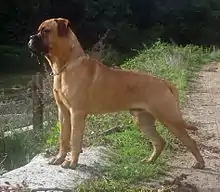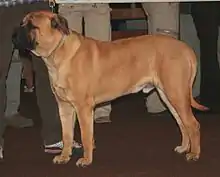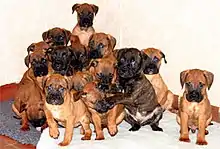Bullmastiff
The Bullmastiff is an English breed of dog of mastiff type and large size, with a solid build and a short muzzle. It was developed as a guard dog in the nineteenth century by cross-breeding the English Mastiff with the now-extinct Old English Bulldog. It was recognised as a breed by The Kennel Club in 1924.
| Bullmastiff Dog | |||||||||||||||||||||||||||||
|---|---|---|---|---|---|---|---|---|---|---|---|---|---|---|---|---|---|---|---|---|---|---|---|---|---|---|---|---|---|
 | |||||||||||||||||||||||||||||
| Origin | England | ||||||||||||||||||||||||||||
| |||||||||||||||||||||||||||||
| |||||||||||||||||||||||||||||
| Dog (domestic dog) | |||||||||||||||||||||||||||||
History
The origins of the Bullmastiff are unclear. In the eighteenth century, in some regions of England, the Old English Mastiff and English Bulldog were commonly inter-bred to produce dogs suitable for work guarding people and their property. By the beginning of the twentieth century this cross-breed was in widespread use as an aid to gamekeepers in the control of poaching.[2] They were bred by gamekeepers for strength, size and speed using a cross of the tough, heavy and aggressive Bulldog of the nineteenth century with the large, strong, less aggressive Mastiff.[3] As a result, the Bullmastiff is known as the Gamekeeper's Night Dog.
The Bullmastiff was recognised as a breed by The Kennel Club in 1924. Dogs had to have a minimum of four generations of descent from Bullmastiff stock without input from either Bulldog or Mastiff; cross-bred animals could not be registered.[2] The American Kennel Club recognised it in 1934.[4] It was definitively accepted by the Fédération Cynologique Internationale in 1955.[5]
In 1928, the diamond mining company De Beers imported Bullmastiffs to South Africa to guard the mines.[6]
Appearance




.jpg.webp)
The Bullmastiff is a large dog. Bitches stand some 61–66 cm at the withers, and usually weigh 41–50 kg; on average, dogs stand about 3 cm taller and weigh 9 kg more.[1]
The coat may be fawn, red or brindle, in any shade; some limited white marking on the chest is allowed. The muzzle is black, becoming paler towards the eyes.[1]
It is a brachycephalic dog, flat-faced and short-muzzled, but this does not affect its breathing.[7]
Health
A UK survey based on the lifespan of 96 Bullmastiffs found a median age of 7.5 years.[8]
Health concerns within the breed include hip and elbow dysplasia, progressive retinal atrophy, bloat, and cancer, with a relatively high incidence of lymphoma and mast cell tumours.[9][10][11] Bullmastiffs are prone to certain hereditary diseases, including:
- Hip dysplasia, affecting 24.5% of individuals [12]
- Elbow dysplasia, affecting 13.8% of individuals,[13]
- Entropion, hypothyroidism affecting 2.8% of individuals,[14]
- Lymphoma
- Progressive retinal atrophy is a particular problem, since the trait is an autosomal dominant one. (This has recently been called into question by another medical team and has been proven that some Bullmastiffs have autosomal recessive PRA genes. In America, this is being investigated by the American Bullmastiff Health and Research Committee, and the DNA Optigen test only works for dominant genes, so it is considered inadequate at this time.)[15]
References
- FCI-Standard N° 157: Bullmastiff. Fédération Cynologique Internationale. Accessed February 2022.
- Eric Makins ([1938]). The Bullmastiff. Manchester: 'Our Dogs' Publishing Co.
- Walkey B. The Bullmastiff Fancier's Manual. Sechelt B.C., Canada: Coast Arts Publishing; 1992
- Get to Know the Bullmastiff. The American Kennel Club. Retrieved 29 May 2014.
- FCI breeds nomenclature: Bullmastiff (157). Fédération Cynologique Internationale. Accessed February 2022.
- "Breed standard (Appendix A)" (PDF). Sabt.co.za. Archived from the original (PDF) on 16 August 2012. Retrieved 18 September 2012.
- Brachycephalic dogs. The Kennel Club.
- "Individual Breed Results for Purebred Dog Health Survey". Archived from the original on 4 May 2007. Retrieved 26 June 2012.
- Bell J, Cavanagh K, Tilley L, Smith FWK. Veterinary Medical Guide to Dog and Cat Breeds. Hoboken: Teton NewMedia; 2012.
- Edwards DS, Henley WE, Harding EF, Dobson JM, Wood JLN (2003). "Breed incidence of lymphoma in a UK population of insured dogs". Veterinary and Comparative Oncology. 1 (4): 200–6. doi:10.1111/j.1476-5810.2003.00025.x. PMID 19379181.
{{cite journal}}: CS1 maint: multiple names: authors list (link) - Dobson JM (2013). "Breed-predisposition to cancer in pedigree dogs". ISRN Veterinary Science. 2013: 1–23. doi:10.1155/2013/941275. PMC 3658424. PMID 23738139.
- Orthopedic Foundation for Animals. "Hip Dysplasia Statistics". Archived from the original on 19 October 2010. Retrieved 11 June 2013.
- Orthopedic Foundation for Animals. "Elbow Dysplasia Statistics". Archived from the original on 3 September 2011. Retrieved 11 June 2013.
- Orthopedic Foundation for Animals. "Thyroid Statistics". Archived from the original on 30 May 2013. Retrieved 11 June 2013.
- "PRA". Swedish Bullmastiff Club. 6 April 2023.